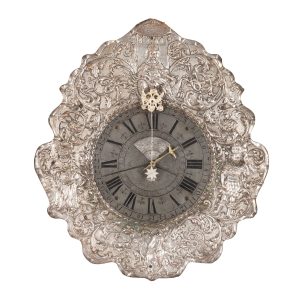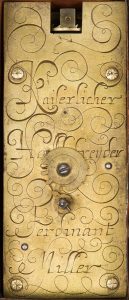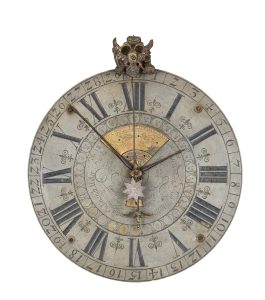Vienna, around 1690
- signed
- “Kaiserlicher Hoffbefreyder Ferdinant Miller” (signed on dial and plate)
- Clockmaker
- Ferdinand Miller,
- Vienna, “kaiserlicher Hofbefreiter” (courtly title), from Friedberg (mentd. in 1683)
- Case
- silver-plated brass, repoussé-work décor with scrolling foliage and personifications of the four continents
- Dial
- silver-plated dial,
three hands for hour, date and lunar phase,
large aperture for month, zodiac, length of day,
sun rise and planets,
small aperture for length of night and sun set - Movement
- verge escapement, fixed barrel with stop wind, short front pendulum, star shaped bob, imperial double eagle as verge-bearing
- Measurements
- 18 ½×16 ½ in
With its extraordinary indications, this fantastic timepiece represents a one-of-a-kind highlight of the plate-shaped style of wall clock. The splendid front is decorated using the repoussé technique with personifications of the four continents – a nod to the complex, global displays. Europe – depicted as a queen reigning beneath a canopy with martial symbols – is located above the dial. On the right, we see America with a feather headdress and parrot, to the left Africa with a lion, and finally at the bottom Asia with a crescent staff and snake. An imperial double eagle at the upper end of the pendulum suggests an illustrious commissioner.
The three hands of the dial display the hour, date (outer chapter ring with the numbers 1 through 30) and the phase of the moon (hoop with the various shapes of light of the moon). An aperture in the form of a segmented circle features indications of the month, zodiac signs, day length, sunrise, and planets; a second smaller opening shows the night length and sunset. Hour, date and moon phase are operated by the movement, the remaining displays are manually adjustable.
Both the clock case and the movement are similar to the grand Friedberg and Augsburg plate-shaped wall clocks, so it comes as no surprise that mention was made of the master Ferdinand Miller in Friedberg in 1683. After being appointed as a clockmaker exempted by the court, however, he had to serve Emperor Charles VI and his royal household in Vienna. The title of “exempted craftsman”, which was associated with numerous privileges and could not be inherited, was granted only to a select handful of the very best craftsmen and is, like this museum-quality astronomical wall clock, a testimony to the exceptional skills of the imperial clockmaker Ferdinand Miller.



